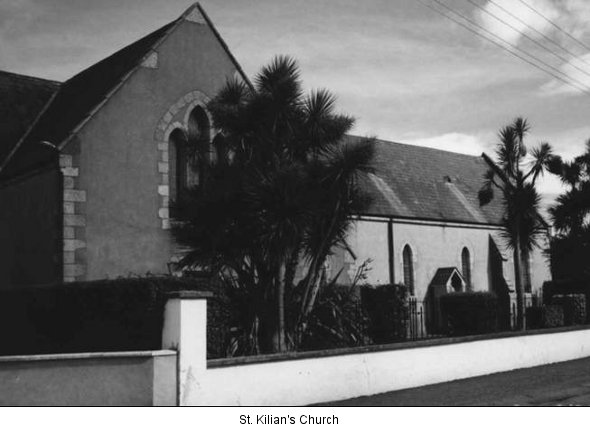Journal Volume 3 2000
Places of Worship in Greystones (continued/4)
St Kilian's Church
Samuel French says in his local history booklet that 'formerly St Kilian's Roman Catholic Church at Blacklion served Greystones...'. This, the earliest place of Catholic worship in the Greystones area in modern times, is in the townland of Kindlestown Lower. One Thomas Phelan bequeathed the site in 1857. He was, almost certainly, the Thomas Phelan who according to the Valuation of Sir Richard John Griffith, Bart (1784-1878), held land and a plantation in the townlands of Kilmurry North and Kilmacanogue South in 1852. It is recorded in Father O'Sullivan's 1966 booklet that a two-room schoolhouse was built on the half-acre site. I wonder what ever became of that little building?
The lease on the site was for five hundred years, subject to an annual payment of one shilling. It was Thomas Phelan's wish that a chapel be built upon the site before 14 August 1867 - within ten years of his demise, presumably. The parish priest of Kilmacanogue and Bray, Father Alexander Roche, under whose pastoral care this district was at the time, felt that the area was sufficiently well served by the recently established Carmelite convent [chapel] in Delgany: there was besides the difficulty of collecting money to build a chapel. However, Dean Walter Lee, who in 1865 was (according to the bicentenary history of the Church of the Holy Redeemer in Bray) parish priest of Bray and Greystones, was asked by Archbishop (afterwards Cardinal) Paul Cullen to build a chapel, in order to fulfil the testamentary wishes of Thomas Phelan and secure the use of the site.

By 20 September of that year (1865) three hundred pounds had been subscribed, including a one-hundred-golden gold coin from the Empress of Austria - a gesture, it is thought, in memory of the seventh-century missionary St Kilian, to whom the proposed place of worship was to be dedicated. Included too was a ten-pound donation from the owners of twelve Greystones fishing boats, and what was then the munificent sum of one hundred and fifty pounds from a single subscriber, P McMullan.
Work commenced in 1866, the foundation stone having been laid by Father Lee, the parish priest (variously titled dean, canon, monsignor and doctor) on 10 October. The deadline for completion was met and the chapel, which consisted of the nave portion only of the present edifice, was opened for public worship on 14 August 1867, Mass having been first celebrated in it by Canon Lee on the fifth of that month. At Canon Lee's sole expense was erected over the high altar a statue (or stone effigy) of St Kilian by an eminent Bavarian artist, Arnold Fussengang.
In the two decades that followed the opening of the chapel the population of the area continued to increase, so that it was found necessary to enlarge the building. In August 1886 Archbishop William Joseph Walsh presided at a meeting in Greystones at which it was decided to enlarge St Kilian's chapel: the archbishop laid the first stone of the new extension. The sum of one thousand pounds was spent on the building, which was soon to have transepts east and west, and a choir tin the architectural sense). The altar was moved to the new small chancel. On 1 August 1887 the extended building, now officially designated St Kilian's Church, was blessed by Archbishop Walsh in the presence of the apolostic nuncio, Monsignor Persico.
We're told that two years later (that is to say, in 1889) Father Edmund Looby, assistant priest in Bray, was sent to reside in Greystones and give the people two Masses on Sundays in St Kilian's. The Very Revd Bernard Brady, PP issued a booklet commemorating the enlargement of St Kilian’s, during celebrations held in November 1986. From Father Brady's booklet has been drawn some of the information for this talk. It is to be hoped that when the full history of the parish based on primary sources comes to be written, many of the conflicting statements met with in the several publications which I have consulted will be thoroughly investigated and evaluated, and the record set straight. A complete succession list of clergy, with their dates, would of course be essential, so that we would know at least whether it was Father Looby or Father Moore who was the first curate to come here as resident priest.
You may wonder why the statue of St Kilian is now on the outside north wall of the church and not above the altar as it originally was. The statue was moved in Canon Fennelly's time and a new inscription slab affixed underneath. The piece of ground to the east of the church was cleared recently and a curate's house built on it. So for the first time in the history of the parish, as far as we can ascertain at any rate, there is a resident priest here at St Kilian's.


